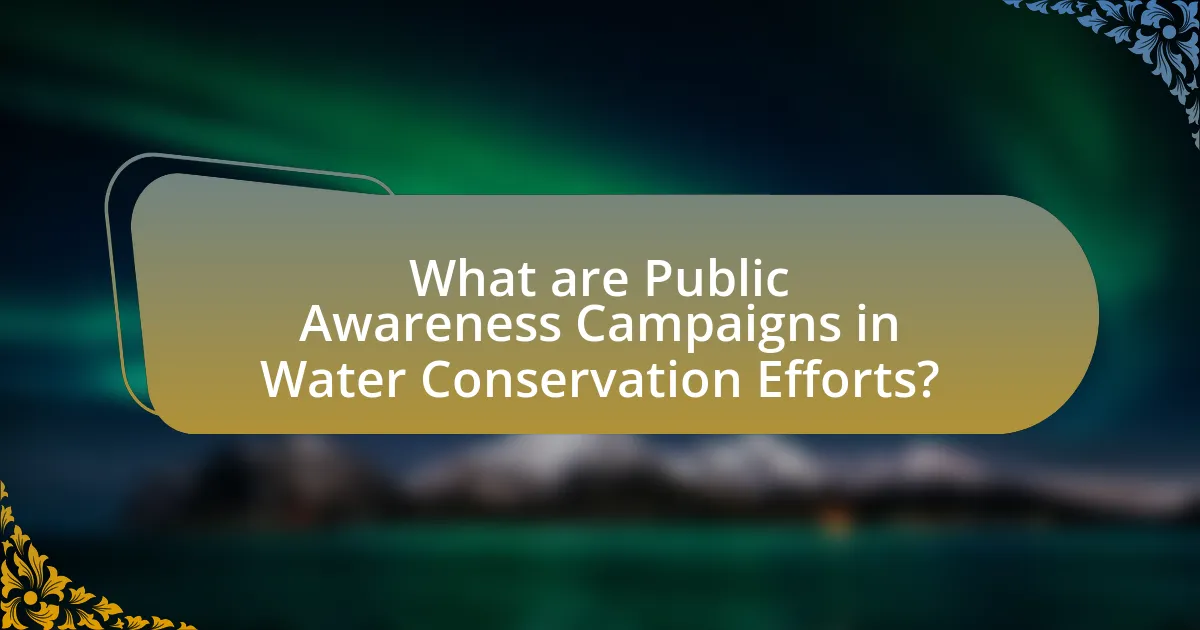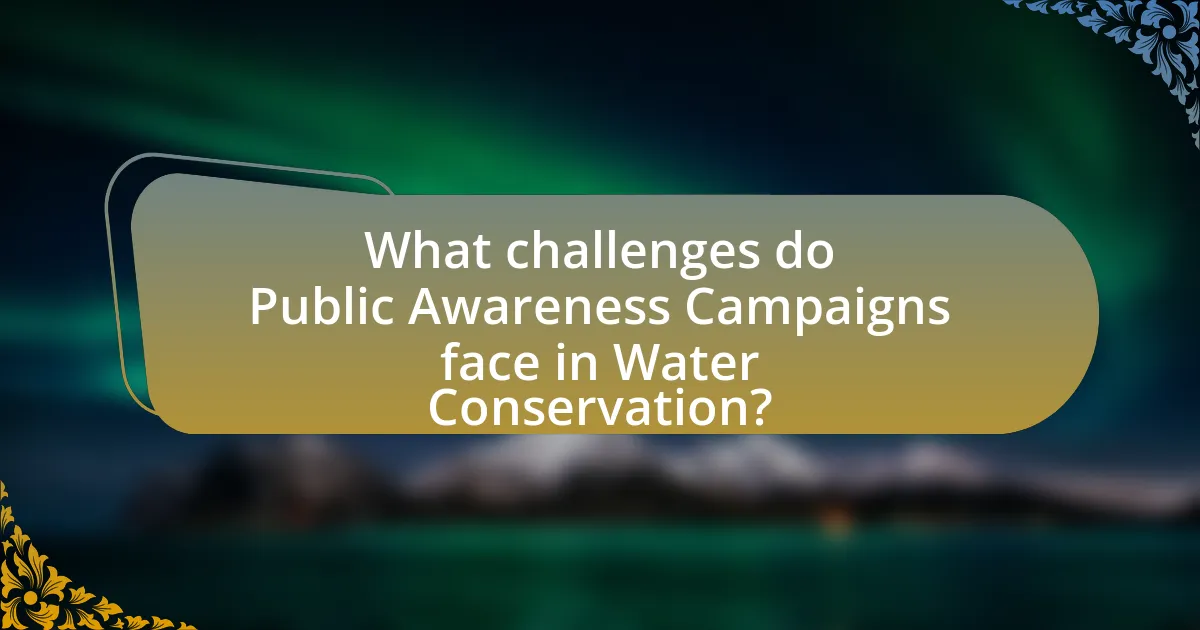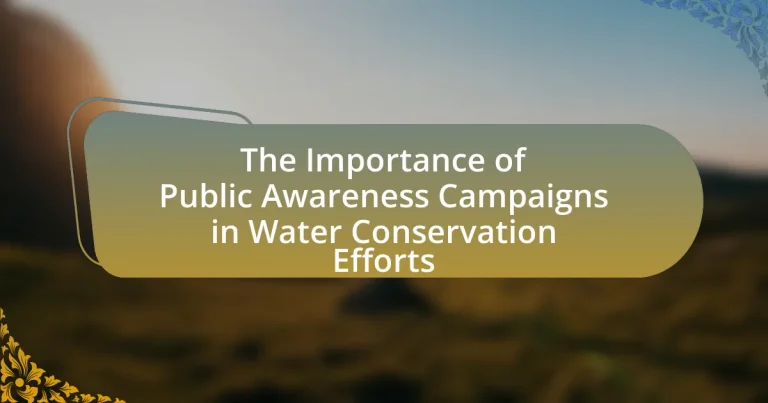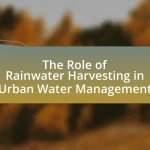Public awareness campaigns in water conservation efforts are organized initiatives designed to educate the public about the significance of conserving water and promoting sustainable usage practices. These campaigns employ various strategies, including educational outreach, community engagement, and social media promotion, to raise awareness about water scarcity and encourage behavioral changes. Effective campaigns can lead to measurable reductions in water consumption, influence policy changes, and enhance community involvement. Key components of successful campaigns include clear messaging, targeted audience engagement, and the use of diverse media channels to maximize outreach and impact. Challenges such as misinformation and public apathy must be addressed to ensure the effectiveness of these initiatives in fostering sustainable water management practices.

What are Public Awareness Campaigns in Water Conservation Efforts?
Public awareness campaigns in water conservation efforts are organized initiatives aimed at educating the public about the importance of water conservation and promoting sustainable water use practices. These campaigns utilize various communication strategies, such as social media, community events, and educational materials, to raise awareness about water scarcity issues and encourage behavioral changes that lead to reduced water consumption. For instance, the United Nations’ World Water Day campaigns have successfully highlighted the global water crisis, leading to increased public engagement and policy advocacy for water conservation measures.
How do Public Awareness Campaigns influence water conservation behaviors?
Public awareness campaigns significantly influence water conservation behaviors by educating individuals about the importance of water conservation and providing practical strategies for reducing water usage. Research indicates that campaigns utilizing clear messaging and community engagement can lead to measurable reductions in water consumption; for instance, a study by the American Water Works Association found that targeted outreach efforts resulted in a 15% decrease in residential water use in participating communities. These campaigns often employ various media channels to reach diverse audiences, thereby increasing awareness and prompting behavioral changes that contribute to sustainable water management.
What strategies are commonly used in these campaigns?
Public awareness campaigns in water conservation efforts commonly utilize strategies such as educational outreach, community engagement, social media promotion, and partnerships with local organizations. Educational outreach involves workshops and informational materials that inform the public about water-saving techniques and the importance of conservation. Community engagement fosters local involvement through events and initiatives that encourage residents to participate in conservation activities. Social media promotion leverages platforms to spread awareness and share tips on water conservation, reaching a broader audience quickly. Partnerships with local organizations enhance the campaign’s credibility and effectiveness by combining resources and expertise to amplify the message. These strategies have been shown to increase public knowledge and participation in water conservation efforts, as evidenced by various successful campaigns across different regions.
How do these strategies engage the community?
Public awareness campaigns in water conservation efforts engage the community by fostering participation and encouraging behavioral change. These strategies utilize educational outreach, social media, and community events to inform residents about the importance of water conservation, leading to increased awareness and action. For instance, studies show that communities involved in local conservation initiatives report a 20% reduction in water usage, demonstrating the effectiveness of these engagement strategies.
Why are Public Awareness Campaigns essential for water conservation?
Public awareness campaigns are essential for water conservation because they educate communities about the importance of saving water and promote sustainable practices. These campaigns effectively communicate the critical state of global water resources, highlighting that, according to the United Nations, over 2 billion people live in water-stressed areas. By raising awareness, these initiatives encourage behavioral changes, such as reducing water waste and adopting water-efficient technologies, which can lead to significant reductions in water consumption. Furthermore, studies have shown that communities engaged in awareness campaigns can reduce water usage by up to 20%, demonstrating the tangible impact of informed public action on water conservation efforts.
What role do they play in educating the public?
Public awareness campaigns play a crucial role in educating the public about water conservation. These campaigns disseminate information on the importance of conserving water, practical methods for reducing water usage, and the environmental impact of water waste. For instance, studies have shown that communities exposed to targeted water conservation campaigns can reduce their water consumption by up to 20%. This effectiveness is often attributed to the clear messaging and community engagement strategies employed in these campaigns, which help to raise awareness and change behaviors regarding water use.
How do they contribute to policy changes and community initiatives?
Public awareness campaigns contribute to policy changes and community initiatives by educating the public on water conservation issues, thereby influencing public opinion and encouraging civic engagement. These campaigns often provide data and case studies that highlight the importance of sustainable water practices, which can lead to increased support for policies aimed at water conservation. For example, campaigns that demonstrate the economic benefits of reducing water waste can persuade policymakers to implement regulations that promote efficient water use. Additionally, successful community initiatives, such as local clean-up events or water-saving challenges, can serve as models for broader policy adoption, showcasing effective strategies that can be replicated at larger scales.

What are the key components of effective Public Awareness Campaigns?
The key components of effective Public Awareness Campaigns include clear messaging, targeted audience engagement, strategic use of media, and measurable objectives. Clear messaging ensures that the campaign communicates its purpose and goals succinctly, making it easier for the audience to understand the importance of water conservation. Targeted audience engagement involves identifying specific demographics that are most affected by water issues, allowing for tailored approaches that resonate with those groups. Strategic use of media encompasses selecting appropriate channels—such as social media, television, and community events—to maximize reach and impact. Finally, measurable objectives allow campaign organizers to assess effectiveness through metrics such as increased awareness levels or behavioral changes regarding water usage. These components collectively enhance the campaign’s ability to inform and motivate the public towards water conservation efforts.
How can messaging be tailored to different audiences?
Messaging can be tailored to different audiences by understanding their specific needs, values, and communication preferences. For instance, a campaign targeting urban residents may emphasize the economic benefits of water conservation, while messaging for rural communities might focus on the environmental impact and sustainability of local water sources. Research shows that demographic factors such as age, education level, and cultural background significantly influence how individuals respond to messaging, making it essential to customize content accordingly. By utilizing audience segmentation and targeted messaging strategies, campaigns can effectively engage diverse groups and enhance the overall impact of water conservation efforts.
What are the best practices for creating relatable content?
The best practices for creating relatable content include understanding your audience, using authentic storytelling, and incorporating emotional triggers. Understanding your audience allows content creators to tailor messages that resonate with specific demographics, increasing engagement. Authentic storytelling fosters a connection by sharing real experiences or challenges, making the content more relatable. Incorporating emotional triggers, such as humor or empathy, can enhance relatability by evoking feelings that align with the audience’s experiences. Research indicates that content that resonates emotionally is more likely to be shared, amplifying its reach and impact, particularly in public awareness campaigns like those for water conservation.
How can cultural factors influence campaign effectiveness?
Cultural factors significantly influence campaign effectiveness by shaping perceptions, values, and behaviors related to water conservation. For instance, communities with strong environmental values may respond more positively to campaigns that emphasize sustainability and ecological responsibility. Research indicates that culturally tailored messages resonate better; a study published in the Journal of Environmental Psychology found that campaigns aligned with local cultural norms increased engagement by 30%. Additionally, understanding cultural symbols and practices can enhance message relevance, leading to higher participation rates in conservation efforts.
What channels are most effective for disseminating campaign messages?
Digital channels, particularly social media platforms, are the most effective for disseminating campaign messages. Research indicates that social media allows for rapid sharing and engagement, reaching diverse audiences quickly. For instance, a study by the Pew Research Center found that 69% of adults in the U.S. use social media, making it a powerful tool for awareness campaigns. Additionally, email marketing and targeted online ads complement social media efforts by providing direct communication to interested individuals, enhancing message retention and action.
How do social media platforms enhance outreach?
Social media platforms enhance outreach by providing a vast network for information dissemination and engagement. These platforms allow organizations to reach a global audience instantly, facilitating the sharing of messages related to water conservation efforts. For instance, studies show that campaigns utilizing social media can increase public engagement by up to 50%, as users share content within their networks, amplifying the message’s reach. Additionally, social media enables targeted advertising, allowing campaigns to focus on specific demographics interested in environmental issues, thereby increasing the effectiveness of outreach efforts.
What role do local events play in promoting awareness?
Local events play a crucial role in promoting awareness by providing a platform for community engagement and education. These events facilitate direct interaction between individuals and organizations focused on water conservation, allowing for the dissemination of information and resources. For instance, community workshops and festivals often feature demonstrations, informational booths, and expert talks that highlight the importance of water conservation practices. Research indicates that participation in local events can increase knowledge retention and behavioral change regarding environmental issues, as evidenced by studies showing that attendees are more likely to adopt water-saving measures after engaging in such activities.

What challenges do Public Awareness Campaigns face in Water Conservation?
Public awareness campaigns in water conservation face several significant challenges, including limited public engagement, misinformation, and varying cultural attitudes towards water use. Limited public engagement often results from a lack of interest or perceived relevance, making it difficult for campaigns to effectively communicate their messages. Misinformation can spread rapidly, leading to confusion about water conservation practices and undermining campaign efforts. Additionally, cultural attitudes towards water use can vary widely, with some communities prioritizing water conservation while others may not recognize its importance, complicating the implementation of uniform messaging. These challenges hinder the effectiveness of campaigns aimed at promoting sustainable water use practices.
How can misinformation impact water conservation efforts?
Misinformation can significantly undermine water conservation efforts by creating confusion and mistrust among the public regarding water-saving practices. For instance, false claims about the ineffectiveness of certain conservation methods can lead individuals to abandon or ignore these practices, resulting in increased water consumption. A study by the Water Research Foundation found that communities exposed to misinformation about water scarcity were less likely to engage in conservation behaviors, leading to a measurable increase in water usage during drought conditions. This demonstrates that accurate information is crucial for fostering effective water conservation initiatives.
What strategies can combat misinformation in campaigns?
To combat misinformation in campaigns, implementing fact-checking mechanisms is essential. Fact-checking organizations, such as Snopes and PolitiFact, provide verified information that can counter false claims effectively. Additionally, utilizing social media platforms to promote accurate information and engage with the audience helps clarify misconceptions. Research indicates that campaigns employing transparency and providing sources for their claims significantly reduce the spread of misinformation. For instance, a study by the Pew Research Center found that 64% of Americans believe that social media platforms should take stronger actions against misinformation.
How can campaigns adapt to changing public perceptions?
Campaigns can adapt to changing public perceptions by continuously monitoring public sentiment and adjusting their messaging accordingly. Utilizing tools such as social media analytics, surveys, and focus groups allows campaigns to gather real-time feedback on public attitudes towards water conservation. For instance, a study by the Water Research Foundation found that campaigns that incorporated community input and responded to local concerns saw a 30% increase in engagement. By being responsive and flexible, campaigns can ensure their strategies remain relevant and effective in promoting water conservation efforts.
What are the common barriers to public engagement in water conservation?
Common barriers to public engagement in water conservation include lack of awareness, perceived inconvenience, and insufficient incentives. Many individuals are unaware of the severity of water scarcity issues, which diminishes their motivation to participate in conservation efforts. Additionally, people often view water-saving practices as inconvenient or time-consuming, leading to resistance in adopting these behaviors. Furthermore, the absence of tangible incentives, such as financial rewards or community recognition, can hinder public involvement. Research indicates that effective public awareness campaigns can address these barriers by educating communities, simplifying conservation practices, and providing incentives, thereby enhancing engagement in water conservation initiatives.
How can campaigns address apathy or indifference towards water issues?
Campaigns can address apathy or indifference towards water issues by employing targeted messaging that highlights the immediate and personal impacts of water scarcity. For instance, campaigns can utilize statistics showing that over 2 billion people live in water-stressed countries, emphasizing how water scarcity affects health, agriculture, and economic stability. By sharing relatable stories and visuals that connect water issues to daily life, campaigns can foster emotional engagement and a sense of urgency. Additionally, interactive elements such as community events or social media challenges can encourage participation and create a collective sense of responsibility, making the issue more tangible and relevant to individuals.
What methods can be used to increase community involvement?
To increase community involvement in water conservation efforts, methods such as organizing educational workshops, implementing community clean-up events, and utilizing social media campaigns can be effective. Educational workshops provide residents with knowledge about water conservation techniques and the importance of preserving water resources, fostering a sense of responsibility. Community clean-up events engage residents in hands-on activities that directly impact their local environment, promoting teamwork and awareness. Social media campaigns can reach a broader audience, encouraging participation through interactive content and sharing success stories, which can motivate others to get involved. These methods have been shown to enhance community engagement and awareness, leading to more sustainable water conservation practices.
What are some practical tips for launching a successful Public Awareness Campaign?
To launch a successful Public Awareness Campaign, clearly define your objectives and target audience. Establishing specific goals, such as increasing water conservation awareness by 30% within six months, provides a measurable framework for success. Utilize various communication channels, including social media, community events, and local media, to reach a broader audience effectively. For instance, a campaign in California successfully increased water-saving behaviors by 20% through targeted social media ads and community workshops. Collaborate with local organizations and influencers to enhance credibility and extend reach. Engaging storytelling and relatable messaging can significantly impact audience connection, as evidenced by the “Save Water” campaign, which utilized personal stories to resonate with the public. Finally, monitor and evaluate the campaign’s effectiveness through surveys and feedback to adjust strategies as needed, ensuring continuous improvement and engagement.


